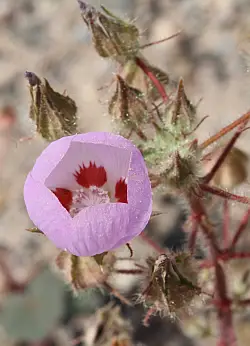Into the Valley of Life - Page 2
By Chris Epting

Thousands of years ago in the Pleistocene era, there were large lakes (including Lake Manly) in Death Valley. As the bodies of water dried up, small streams and pools managed to survive. The pupfish (named for the way they frolic in the water) were trapped in these shrinking pools, selected by evolution to survive and eventually becoming the species we know today.
There are a number of types of pupfish in Death Valley, each stranger and more rare than the next. These species include:
- The Saratoga pupfish, located at the south end of Death Valley.
- The highly endangered Devil's Hole pupfish, found 37 miles east of Furnace Creek, in western Nevada.
- The Cottonball Marsh pupfish, found in Cottonball Marsh on the west side of central Death Valley.
- The famed Salt Creek pupfish, located in Salt Creek in the central part of Death Valley.
Easily visible for just a few months each year, the inch-long fish can survive in water temperatures that exceed 112 degrees F. In fact, the tiny fish are so adapted to warm water that they must burrow into the mud and become dormant when the shallow stream becomes cold in the winter. Another hurdle these fish face is high salinity. Pupfish can actually live in water that's up to three times saltier than ocean water.
Watching the pupfish in the crystal-clear pools along a boardwalk is a thrilling bit of business; a real-time evolutionary study. They represent life at its finest—in a place where we typically do not associate life at it finest.

Badwater Basin
Similar charms also exist at Badwater Basin, the lowest point in North America, 282 feet below sea level. The spring-fed pool of supp-briny "bad water" located near the road before the vast white expanse of salt-covered ground is home to the Badwater snail, a minute marsh snail that also has adapted to the harsh environs.
And adaptation is everything in Death Valley. The plants adapt, the animals adapt, and we adapt for our visits, hauling our water and food and measuring our paces as we search for solitude in the lonely, shimmering heat.

Flowers in the desert
Death Valley, after even a short rain season, presents colorful life if you know where to look. Desert Dandelion, Brittlebush, Princesplume, Desert Paintbrush, Fremont Phacelia, Mojave Aster, Indigo Bush and Desert Globemallow are treats for the eye, and the spirit. Explosions of color carpet various parts of the valley; artfully reminding us that life is where you look for it.
And then you sometimes get the unexpected moment that forever erases any sense of fear or intimidation in Death Valley. For us, it was a tired-looking coyote that approached us as we meandered back from looking at wildflowers. Studying us from just several feet away, she (I think it was a she) seemed bashful, curious, suspicious, and bashful again, all in the span of about 15 seconds. For several minutes she kept us company. Eyeing us. Licking her chops. Then she wandered off into the salt pan, in search perhaps of food, water, or a cool place to rest.
Death Valley, for me, is a life-affirming place. We escape there to remove ourselves from the life we know, and in turn we encounter life we want to know. The wild, the threatened, the rare and obscure, all thrown together in a pocket of parched, lonely planet bliss that bares a scary name.
But it's not a scary place at all. It's holy and naturally sacred, a testament to those that can survive the scorching brutality.
"What makes the desert beautiful is that somewhere it hides a well," said de Saint-Exupery. This is true. But when it comes to Death Valley, the well may not even be hidden. It is the life before you; it is the pulse in the warm wind, in the sand and in the billions of stars overhead as you lay down to sleep.
I wish they'd rename Death Valley.
Chris Epting is the writer/photographer of 18 books, including Hello, It's Me - Dispatches From a Pop Culture Junkie. Others include James Dean Died Here; Led Zeppelin Crashed Here; Roadside Baseball; and The Ruby Slippers, Madonna's Bra, and Einstein's Brain. He has contributed articles for such publications as the Los Angeles Times, Westways, Travel + Leisure and Preservation magazine, and is the National Spokesman for the Hampton hotel Save-A-Landmark program. Chris lives in Huntington Beach, CA with his wife and their two children.
Photos by Chris Epting and Charlie Epting.
Related articles:
Let's Spend The Night Together by Chris Epting
Travel by the Glass by Chris Epting
Do More With Less: Survival, Then Surviving Scotch by Bruce Northam
Sex, Lies, and Desert Dust at Burning Man by Brad Olsen
Other United States and Canada travel stories from the archives
Copyright (C) Perceptive Travel 2011. All rights reserved.
- The Covert Casanova Tour by Tony Perrottet
- My Life and Times With the CN Tower by Amy Rosen
- World Music Reviews
Books from the Author:

Buy Hello It's Me at your local bookstore, or get it online here:
Amazon US
Amazon Canada
Amazon UK

Buy The Birthplace Book at your local bookstore, or get it online here:
Amazon US
Amazon Canada
Amazon UK

Buy Led Zeppelin Crashed Here at your local bookstore, or get it online here:
Amazon US
Amazon Canada
Amazon UK

